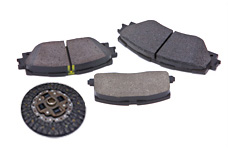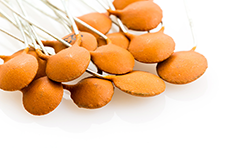Products

We offer phenolic resins as binder for friction materials which are used for brake linings, brake pads, clutch plates of transmission and others with superior heat resistance and adhesive performance.
Plants
- Shizuoka Plant
- P.T. Indopherin Jaya (Indonesia)
- Sumitomo Bakelite (Nantong) Co., Ltd. (China)
- Durez Corporation (USA)
- Sumitomo Bakelite Europe NV (Belgium)
- Sumitomo Bakelite Europe (Barcelona), S.L.U. (Spain)
Laboratories
- High Performance Plastic Technology Development Laboratory
- Sumitomo Bakelite Europe NV (Belgium)
LCA Study
Here is an example of LCA study of an application in which our phenolic resin
is used.
This shows the effect of reducing CO2 emissions when phenolic resins for friction
material are replaced with biomass-based materials from conventional materials.
We use MiLCA, a globally recognized LCA calculation module for calculation. Please contact
us for more information.
CO2 Emission Reduction Effect (Resin For Brake Friction Material)

| CO2 emissions
(kg-CO2eq/kg) Equipment to 1 Passenger Car |
Notes | |||
|---|---|---|---|---|
| Conventional Resin |
Biomass Resin |
Shorter Process Resin |
||
| Straight Powder Resin |
30% Lignin Modified Resin |
Low Temp. Cure Resin |
Shorten Process Resin: Assuming Energy reduction at product of pad by 30% |
|
| Friction material: as a whole (a) <>Only Resin potion (weight%) |
N/A <0.42> |
N/A <0.36> |
N/A <0.42> |
Resin Content 0.1% |
| Pad manufacturing (b) | 2.6 | ← | 1.8 | Resin types do not matter to the numbers |
| Impact on driving (c) | 8.8 | ← | ← | Replacing cycle 50,000km |
| Disposal (incineration, recycling, etc.) (d) <>Only Resin potion (weight%) |
N/A <0.14> |
N/A <0.10> |
N/A <0.14> |
Resin Content 0.1% |
| Sum | 11.96 | <11.86> | <11.16> | |
| CO2 Reduction from Conventional material (Per vehicle) |
↓ 0.1kg |
↓ 0.8kg |
As 0.25 kg/pad x 4/front wheel | |
CO2 Reduction from Conventional material to Biomass Resin
0.09kg and
to Shorter Process Resinamount 0.8㎏-CO2eq per vehicle.
Remark
- CO2 emissions and reductions are only for resin in friction
- These data are representative values based on conditions in the tire production process and are not guaranteed.
(a)(b)
1) Calculation Conditions
• Data Base: IDEA v2.3
• Impact Area: 100-Year Index (IPCC, 2013)
• Characterization model and target item: Climate change
2) System Boundary:
(a) Raw Material - Product Shipment
(b) Product Production on similar processes
3) Production plant: Sumitomo Bakelite Co., Ltd. Shizuoka Plant
4) Data collection period: April 2021 - March 2022
(c) Cited by JAPIA_LCI_TOOL_USE_PHASE_GENERIC_Ver208
Condition:
Car Type: Four Wheel Passenger Vehicle (WLTP)
Lifetime fuel consumption per 1kg: 1.675L/kg
CO2 emission intensity per energy consumption for gasoline:
2.601kg-CO2/L
Number of putts replaced in Lifetime: 2times
Car the usage, from cradle to grave, of condition is 100,000 kilometers
Molding Parts, Brake pads, are used 8 parts per Car
(d) CO2 emissions theoretically combusted
Using MiLCA, LCA of automotive
molded parts can now be
calculated.
Please use this information for comparison with your company's current parts.
Features
High Performance, High Reliability
We offer various types of phenolic resins which provide superior heat resistance, good flexibility, high mechanical strength and good friction properties.
Applications
Automotive/Railways/Aircraft
Automotive Mechanical components
Brakes
Brake Linings, Brake Pads
Transmission
Clutch Facing, Paper Clutch Facing for MT/AT/DCT
Other Applications
Brake Shoe for train, Friction Materials for industrial brake
Expected Brake Pads Performance vs. Corresponding Type of Phenolic Resin
|
Expected Friction Performance |
◀◀ Focus on
Flexibility ◀◀ (Non-modified
resin) ▶▶ Focus on Heat
Resistance ▶▶
|
|||||
|---|---|---|---|---|---|---|
| Low Noise |
Acryl mod.
PR-55291A |
Acryl mod.
PR-55291 |
Silicone mod.
PR-54529 |
Silicone mod.
PR-56291 |
||
|
Flexibility at low temp. |
||||||
| Water Resistance |
Water Repellency |
|||||
| Wear Resistance |
||||||
| Moldability |
Fast Curing |
|||||
| Eco- friendly |
||||||
Specifications
SUMILITERESIN®PR Series
| Grade | Melting point (°C) | Flow (mm) | Hexamine content | Advantage | Application |
|---|---|---|---|---|---|
| *PR-311 | 83 | 60 | Medium | High heat resistance,
high mechanical strength |
Brake linings |
| PR-12687 | 78 | 45 | Medium | Flexibility | Brake linings (for oversized vehicles) |
| PR-13355 | 80 | 50 | Medium | Flexibility | Brake linings |
| PR-50064 | 90 | 20 | Medium | High heat resistance, high mechanical strength |
Brake pads |
| PR-50069 | 95 | 0 | High | Flexibility | Brake linings, Railway brakes |
| PR-51510 | 88 | 35 | Medium | High heat resistance | Brake linings |
| PR-51794 | 102 | 12 | High | High heat resistance, high mechanical strength |
Brake pads |
| PR-53724 | 93 | 33 | High | High heat resistance, high mechanical strength |
Brake pads |
| PR-53497 | 98 | 27 | High | High heat resistance, Good mechanical strength |
Brake pads |
| PR-54458A | 115 | 39 | Medium | High heat resistance | Brake pads |
| PR-55170 | 89 | 29 | High | High heat resistance | Brake pads |
| PR-51316M | 94 | 51 | Low | High heat resistance, Flexibility |
Brake linings (for oversized vehicles) |
| PR-54529 | 92 | 38 | Medium | Water Repellency, Flexibility |
Brake pads |
| PR-54529H | 94 | 36 | Medium | Water Repellency, Flexibility |
Brake pads |
| PR-56291 | 100 | 18 | Medium | Water Repellency | Brake pads |
| PR-56291L | 92 | 40 | Medium | Water Repellency | Brake pads |
| PR-55291 | - | 40 | Medium | Flexibility | Brake pads |
| PR-55291A | - | 40 | Medium | Flexibility | Brake pads |
| PR-56341 | 97 | 27 | Medium | High heat resistance | Brake pads |
| PR-56531 | - | 25 | Medium | Wear resistance | Brake pads |
| PR-X20068 | - | 15 | Medium | Utilizing Biomass | Brake pads |
| PR-X20084 | - | 26 | Medium | Utilizing Biomass | Brake pads, Brake linings |
Remark
- * Please refer to the poisonous material control law(s) applicable in your country when you use this product.
- The data given above are not guaranteed values.
| Grade | Viscosity (MPa·s) |
Resin content (%) |
Solvent | Modification | Advantage |
|---|---|---|---|---|---|
| PR-50385 | 30 | 40 | Methanol | Cresol | High heat resistance, flexibility |
| PR-53123 | 10 | 45 | Methanol | Alkyl benzene | Good wear resistance |
| PR-53717 | 80 | 50 | Methanol /Toluene |
Oil | Flexibility |
| PR-54562 | 14 | 48 | Methanol | Low molecular weight | Good impregnation performance, high durability |
| PR-55386 | 9 | 38 | Water | Melamine | Water soluble grade (environmental friendly) |
| PR-55536 | 11 | 44 | Acetone | Acrylic polymer | Flexibility |
Remark
- The data given above are not guaranteed values.
Topics More
- 2025/11/13 Products Launch of Mass Production of the Main Deck Cargo Liner for Airbus’ New A350F Freighter Aircraft
- 2025/10/23 Products Announcement of the Development of Wear-Resistant Phenolic Resin for Brake Friction Materials
- 2025/10/16 Products Announcement of the Brand Name and Logo for Ultra-Low Monomer Water-Soluble Phenolic Resin: AQNOA™
- 2025/09/10 Products Expansion of Product Lineup of Tribological (Low Friction and Low Wear) and High-Heat-Resistant Phenolic Resin Molding Compounds
- 2025/06/16 Products Commercialization of the World’s First Biomass-Derived Solid Novolac-Type Lignin-Modified Phenolic Resin













 Inquiry
Inquiry